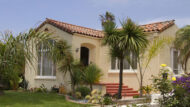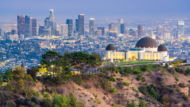If palm trees dot the landscape, you must be in Southern California. The tree is synonymous with LA living, decorating the front yards of mansions, historic central plazas, and even run-of-the-mill strip malls. Even the legendary local burger joint In-N-Out is restricted by two palm trees tied together in front of each establishment. This iconic image also serves as the brand’s logo.
Palms in our city are prevalent because they can live up to 80-90 years, grow up to 75 feet tall, and have leaves that reach about 6 feet long and wide. They’re fairly hard to miss, unless your sunglasses are that dark.
Yet, despite the diversity of these palms in the state, only Washingtonia filifera is native to the state. These palms originally grew in spring-fed Colorado Desert oases deep inside mountain ravines. The Cahuilla and Paiutes tribes used these trees as a natural resource, for both sustenance from the fruit and to weave the fronds into baskets, roofing, and clothing. Other species of palms were imported.
Palms Mark a New Chapter in California’s History
Before the introduction of palms, Southern California’s landscape was a vast expanse of desert, interspersed with grasslands, scrubby chaparral, and pockets of oaky woodland. The transformation began in the 18th century when Spanish Franciscan and Jesuit missionaries, drawn to its biblical significance, planted the first palm trees. These towering figures served not just as ornamentation, but as a symbol of the monks’ monotheistic faith, enhancing the spiritual landscape with their majestic presence. Alongside, they cultivated grapevines, ensuring a steady supply of wine for Holy Communion, further intertwining their religious practices with cultivating the land.
The arrival of the transcontinental railroad in 1876 marked the beginning of Southern California’s first significant population surge. This era, coinciding with the Victorian period, elevated the palm tree to a symbol of discovery, exoticism, and the burgeoning ideologies of exploration and home. In royal botanical gardens and the elite estates, these palms were heralded as emblematic of aesthetic nobility and grace, weaving them into the fabric of the region’s identity.
The burgeoning tourism industry of the time capitalized on the palm tree’s allure, associating it with leisure, luxury, and the exotic appeal of Southern California. This period underscored the palm’s transition from a mere ornamental tree to an integral part of the area’s cultural and social narrative, cementing its role in defining the region’s distinctive character and charm.
Transforming Southern California: The 20th Century Palm Boom
In the 1930s, Southern California underwent a remarkable transformation, with palm trees playing a starring role in its evolution into a semi-tropical haven. The area’s natural ecology was augmented not just by aspiration but through monumental gardening and landscape architecture efforts. In a bid to beautify the city, Pasadena adorned Colorado Boulevard with palms placed at 100-foot intervals, dubbing it the “Street of a Thousand Palms.” Meanwhile, Venice celebrated national pride by planting 200 Washington robusta along Washington Boulevard, in honor of America’s first president.
The following year, Los Angeles’s forestry division undertook a massive beautification project in preparation for the 1932 Olympic games. The city planted an astounding 25,000 palm trees, many of which still grace the streets. This initiative was part of a broader effort to combat the Great Depression; L. Glenn Hall, the city’s first forestry chief, launched an unemployment relief program that invested $100,000 into planting roughly 40,000 trees across 150 miles of city boulevards and employed 400 individuals in the process.
Among these, the oldest palm tree, dating back nearly 150 years, still stands proudly at Exposition Park. This tree and countless others were transplanted during this period, signifying a deep-rooted connection to the city’s history and its enduring commitment to urban greening. These efforts collectively contributed to the iconic landscape of Southern California, intertwining the palm’s legacy with the region’s cultural and environmental tapestry.
How the Palm Tree Was Planted

Acclimatization is crucial for the palm’s survival, with winter posing the most significant challenge. During this time, temperatures dipping below 65 degrees can stunt root growth, curbing the tree’s development. Moreover, excessive water in cooler months risks root weakening and increases the susceptibility to pathogens—a balancing act that requires meticulous care.
A striking feature of non-native palms in California is their prevalence. According to the California Invasive Plant Council, species like the California Fan Palm, the Canary Island Date Palm, and the Mexican Fan Palm dominate the landscape. These species underscore the region’s adaptations and the delicate management required to maintain their iconic presence.
The Declining Future of Palms in Southern California
Sadly, the golden age of palm trees in Southern California is drawing to a close. Beyond battling the natural decline that comes with age, these emblematic trees now face formidable new environmental threats. The arrival of the red palm weevil, first detected in 2010, marked the beginning of these challenges. Though it was successfully eradicated, its impact was significant, paving the way for the South American palm weevil to strain the palm population further.
The sustainability of replacing these majestic trees is now in question. The palm’s substantial water requirements present a dilemma, considering Southern California’s ongoing struggles with water scarcity. As a result, the landscape is gradually shifting, with dead palms being replaced by species that demand less water and provide greater environmental benefits, such as increased shade.
Despite this impending transition, the palm tree remains an iconic symbol of the region. From their historic spread from Spanish missions to embodying the essence of West Coast leisure, palm trees have intricately woven themselves into the cultural fabric of Southern California. Their silhouette against the skyline will always evoke the laid-back, sunny lifestyle that has defined the area for generations.
The Lasting Legacy of Southern California’s Palms
Palm trees, standing tall against the Southern California skyline, tell a story that is uniquely intertwined with the region’s identity and evolution. From Spanish missions introducing the first palms as symbols of their faith, to the lush, decorative visions that marked the streets during the Victorian era, and the mass plantings in the 20th century designed to reshape Los Angeles into a tropical paradise—the palm tree has been a constant, silent witness to history. These trees have marked territories, celebrated progress, and provided a serene backdrop to the city’s bustling life, becoming as much a part of its character as the people themselves.
Yet, as we stand on the brink of a new era, the future of these iconic sentinels hangs in the balance. Environmental challenges and the changing needs of a modern city force a reevaluation of their place in our urban landscape. Despite this, the spirit of the palm tree endures, a reminder of a bygone era of glamour and an emblem of California’s perpetual allure. As Southern California continues to evolve, the legacy of its palms will remain, etched not only in the skyline but in the very essence of what it means to embody the California dream.







